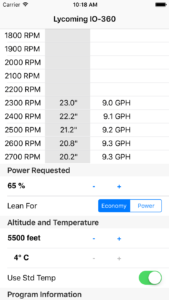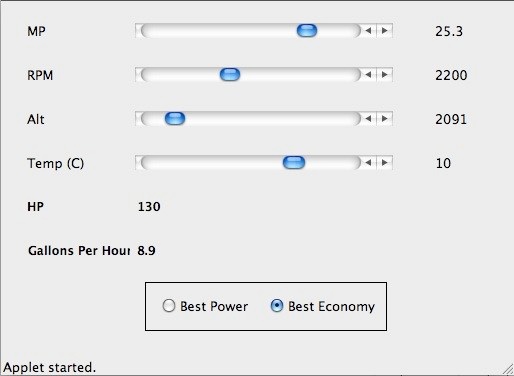 When I bought my Arrow back in 1997, then engine was run out and it had a single probe EGT. I had a MOH done by Penn Yan and installed a JPI EDM 700 4-cylinder CHT/EGT monitor. I then started researching how to fly the engine the way I wanted to – to get longevity from the MOH I had just paid for, and to run efficiently.
When I bought my Arrow back in 1997, then engine was run out and it had a single probe EGT. I had a MOH done by Penn Yan and installed a JPI EDM 700 4-cylinder CHT/EGT monitor. I then started researching how to fly the engine the way I wanted to – to get longevity from the MOH I had just paid for, and to run efficiently.
The Piper manual didn’t provide much help on power settings. The power setting table supplied in the manual (and stenciled on the pilots sun visor) gave the MP settings to be used:
- for best power only
- at either 2100 or 2400 RPM
- for 55%, 65% and 75% power
There was no detailed information about running best economy, at other RPMs, or at other power levels.
The airplane manual had no significant limitations on allowable power settings for the airframe/engine/prop combination.
Fortunately, I also had a copy of the Lycoming Operators Manual (p/n 60297-12). This provided a wealth of information about running the engine – best power vs. best economy, graphs plotting MP and RPM at all altitudes and temperatures, graphs for fuel consumption, etc. The down side of the manual is that it is very hard to extract this information other than while sitting quietly at a desk.
I was looking for a way to actually make this information useful to me.
I decided to try to model the information from the Lycoming manual in a computer program. The first attempt at this was a Java applet, and it produced data that was darn close to that from the manual. (The differences seem to be at most 0.2” of MP – I doubt my MP gauge is that accurate in any case.) This provided me an easier way of asking what-if questions than digging through the graphs.
About the same time I did the Lean Test from GAMI and determined that my injectors were well-matched. Further research convinced me I wanted to routinely run at the lowest RPM that would allow me to reach 65% power, best economy.
The Java applet would allow me to find the appropriate power settings, but the interface was clunky, and it couldn’t be accessed in the plane unless I carried a PC.
My next thought was to craft a version for my Palm PDA – an idea that died because the Palm didn’t support the floating-point operations my model depended on.
The next approach was to take data from the applet and use it to create a spreadsheet that I could print and carry in the plane. The spreadsheet shows the combination of MP and RPM necessary to achieve the given power (at the lowest possible RPM).
 I made these charts for Best Economy and Best Power, laminated them, and have used them for 8 years or so.
I made these charts for Best Economy and Best Power, laminated them, and have used them for 8 years or so.
They work well because they’re quick to use. Their drawbacks are obvious: They only show selected altitudes, only one setting for a given altitude/power, and the temperature conversions need to be manually added.
This iPhone and Android applications are the next step in this process. The same mathematical models are used. These applications attempt to present more data from the models while still being quick and easy to use. The applications do NOT require access to the network to run and so can be used in the air.
The data used in construction the models was extracted from the Operator’s Manual, Textron Lycoming O-360, IO-360, AIO-360, HIO-360 & TIO-360, 5th Edition (Part No. 60297-12).
The specific data used was from:
-
- Figure 3.1. Representative Effect of Fuel/Air Ratio on Cylinder Head Temperature, Power and Specific Fuel Consumption at Constant RPM and Manifold Pressure in Cruise Range Operation
-
- Figure 3.6. Part Throttle Fuel Consumption – IO-360-A, -C, -D, -J, -K; AIO-360 Series
- Figure 3-21. Sea Level and Altitude Performance – IO-360-A, -C, -D, -J, -K; AIO-360 Series
Important Notes:
The mathematical models are applicable only to those IO-360 variants listed above. They do not apply to O-360, HO-360, AIO-360, HIO-360, or TIO-360 engines, nor to any IO-360 variant other than -A, -C, -D, -J, or -K engines.
The models do not take into account any limitations imposed by the installation of these engines in a specific airframe or when mated with a specific propellor.
Best Power: Peak EGT + 150º F
Best Economy: Peak EGT
This information from these applications is intended for educational purposes only and should not be relied on when operating an aircraft. It is up to the pilot to review all official engine and airframe documentation and make appropriate operating decisions.
Note: This app is no longer available. Sorry.
1. I’m not currently involved in aviation.
2. The app generated a lot of questions I’m not in a position to answer. (“Can you explain leaning to me?” “Would there be problems if…?” “Can you make a version for XXX?”)
